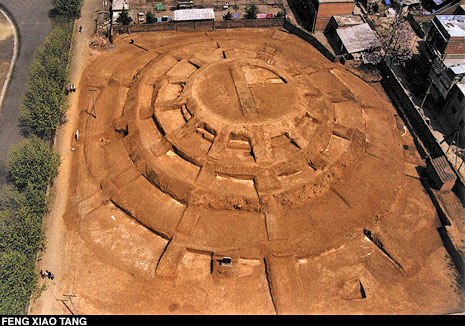|
The Archaeological Institute of America Volume 53 Number 2, March/April 2000 from Archeology Website
The oldest-known altar used in Chinese state religious practice was unearthed, then reburied, this past summer in the city of Xian by the Chinese Academy of Social Sciences. Uncontrolled development around a mysterious circular mound prompted a 30-day salvage excavation.
Constructed as early as the Sui Dynasty
(A.D. 581-618), the so-called Altar of Heaven is more
than 1,000 years older than a similar altar in Beijing, and
is the only one found so far pre-dating the Qing Dynasty
(A.D. 1644-1912). It is estimated that 17 Chinese emperors conducted
religious rites here.
Emperors mounted the steps
of the Altar of Heaven barefoot, accompanied by an
orchestra playing religious hymns, to prostrate themselves before
celestial deities. Their effectiveness as emperors depended on the
proper performance of ritual; otherwise they might be blamed for a
bad harvest or other misfortunes.
The sides and the surfaces of the altarís platforms were covered with a layer of yellow clay, and topped off with a quarter-inch thick layer of gray-white paste, made from seed husks and straw, that gave the altar a white appearance.
The platforms were each between five and seven and one-half feet high and measured from 177 feet in diameter at the bottom to 65 feet at the top. Twelve equally spaced staircases, representing Chinese astronomersí division of the heavens into 12 parts, ascended from the ground to the highest platform. The 12 staircases are the most obvious peculiarity of the Xian Altar of Heaven.
During the
Ming (1368-1644) and Qing (1644-1912)
dynasties, altars had only four staircases, and historical sources
report that Han altars had only eight.
An says that the Xian altar shows that, by contrast, people during the Tang used natural materials and sought simplicity to show the heavens their respect and sincerity.
The altarís
construction may indeed have reflected a resurgence in state
religious practice after years of neglect following the demise of
the Han Dynasty in the third century A.D., says
Timothy H. Barrett of the University of Londonís School of
Oriental and African Studies. The religious rites that evolved
in the Tang Dynasty were a "rethinking of Han
practices," he notes.
The Chinese Academy of Social Sciences team was forced to rebury the altar only weeks after its discovery owing to a lack of funds for a public display.
|
